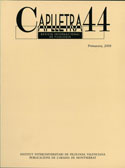Un fals aparegut en el «Tirant lo Blanch»
DOI:
https://doi.org/10.7203/caplletra.44.4798Palabras clave:
Tirant lo Blanc, Rats and Cats, After Death Appearances, Discretio Spiritum, Knightly Parody, Hipòlit Resumen
Resumen
In the chapters CCXXXI-CCXXXIIII of Tirant lo Blanc, there are two
comical scenes where Carmesina and Tirant attempt to keep their love a secret. Carmesina justifies a night riot happened in her chamber by saying that a rat went through her face; whereas Tirant pretends to be a ghost when he runs away from the chamber into the orchard. The dependence of these two episodes opposes the nature of several characters, but the scene that best exhibits the knights’ ambivalent morality is the appearance of Tirant –with the spells of Hipòlit and the viscount of Branches. The comparison of this case with chapter XIX of the «Quixote», and with other works of the modern age, allows to determine how the forms and the meanings of a same commonplace evolve. The appearance of «Tirant» has to be linked especially to three
mediaeval traditions: in the first place, the «fabliaux» and the «novelle», like the «Llibre de fra Bernat» or the «Decamerone»; in the second place, the treaties of ghosts, according to the outlines of «De spiritu Guidonis»; in the third place, the motif of the knightly
adventure, in the way of Chrétien de Troyes. This is how Joanot Martorell balances and adapts diverse materials to the situations that the case brings up.
 Descargas
Descargas
Descargas
Publicado
Cómo citar
-
Resumen388
-
PDF (Català)311
Número
Sección
Licencia
El autor o autora que dirija un trabajo a la redacción de Caplletra para ser publicado tiene que ser la persona titular legítima de los derechos de explotación. La legitimación para la publicación del trabajo tiene que incluir también las imágenes, las tablas, los gráficos y otros materiales que puedan complementar el texto, con independencia de si es su autor o autora.
Copyright. Al publicar el trabajo en la revista, el autor o autora cede a Caplletra. Revista Internacional de Filologia los derechos de explotación (reproducción, distribución y comunicación pública), tanto para la edición impresa en papel como para la versión electrónica.
Todos los trabajos publicados en Caplletra se encuentran bajo una licencia Creative Commons del tipo Reconocimiento-NoComercial-SinObraDerivada 4.0.
RESPONSABILIDAD
Caplletra. Revista Internacional de Filologia no se identifica necesariamente con los puntos de vista sostenidos en los trabajos que publica.Caplletra. Revista Internacional de Filologia declina toda responsabilidad derivada de cualquier vulneración eventual de los derechos de propiedad intelectual que pudiera ser llevada a cabo por los autores o autoras.






